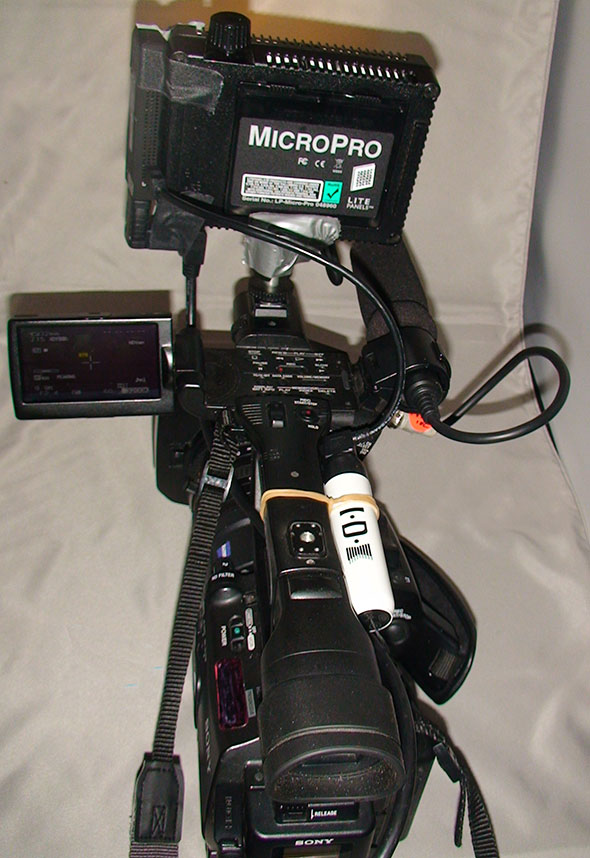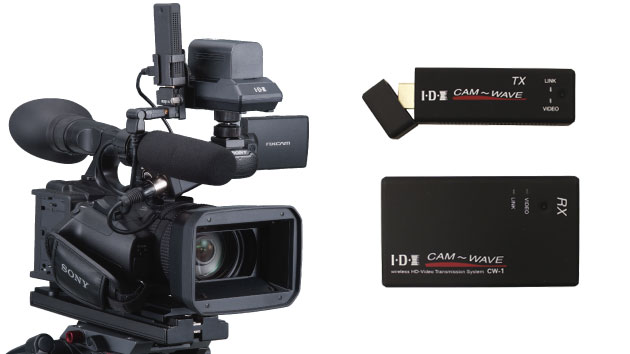At Last, a Reliable and Affordable Solution for Going Cable-less on Challenging HD Shoots
As if live multicamera switching isn't challenging enough, my clients keep coming up with more complicated requests. Most often, they require a camera to be placed hundreds of feet from the switcher, or (worse) mobile. Both requests require laying lots of cable that needs to be taped down to fire department code.
There's pretty much nothing a fire inspector hates more than video cables. I would often have to put in two or three hours laying video cables on the client's bill. Even if it was laid properly, there was still the danger of the cable breaking and losing signal while going live.
The only way to get around cables is to go wireless. Until recently, that meant you were spending $2000 and up on a HD transmitter/receiver set. That all changed at NAB 2016 when I walked into the IDX booth.
IDX is mainly known for V-Mount batteries that power many ENG and cinema cameras, so seeing video transmitters was a bit of a surprise — especially under $800. According to the literature, the CW-1 can transmit up to 300 feet (100 meters) with less than 1 ms of delay.
The system consists of two main units, the transmitter and receiver. The transmitter itself is very small, about four inches long and one inch wide, with an HDMI male end that can plug directly into a camera. If plugging direct doesn't work due to the shape of the camera, the CW-1 is available with a number of optional accessories to mount it other ways.

It may not be the prettiest solution, but I found the best way to mount the transmitter was to tape it to my Litepanels Micro Pro. It fit nicely on the left side.
The transmitter draws power through its mini-USB connector. Out of the box, it comes with a battery and bracket to hold it in a camera accessory shoe, which add about a pound to the camera. If you are already mounting a light and a wireless mic receiver, your camera will get pretty crowded and heavy.
The receiver is about the size of a stack of index cards. It can be powered by a battery or AC power supply. If the receiver is feeding a switcher, there is no reason not to use the AC power supply, saving the second battery as back up for the transmitter.
The first time I used the CW-1 in the field was at a graduation. The last 18 years I'd done this job, I had two stationary cameras feeding a switcher that fed a projector and screen that the audience of several hundred used to see the proceedings. This year, the client wanted a third camera to get some different angles, but wasn't sure where to put it.
We attached the CW-1 transmitter to my Sony HVR-Z7u with a bit of effort and creativity. There was only one accessory shoe on the Z7, and that was being used by a Litepanels Micro Pro. Luckily the Micro Pro has a large flat back. We taped the CW-1 transmitter to the light and attached it to the camera's HDMI port with an extension cable. We put the battery and its receptacle into a fanny pack and ran a USB cable from there to the transmitter, taping both ends securely.
My cameraperson walked around the auditorium to test it out. We could not find any area that caused interference. I wound up having the cameraperson behind the control booth (in the center of the auditorium) for the processional, then at the foot of the stage to get close ups of kids getting awards and diplomas. We did not have a single transmission interruption during the whole 75-minute shoot. Not only that, the quality of the signal was indistinguishable from the hard-wired cameras looking at the live picture or looking at the recorded switcher feed on a Blackmagic Design Hyperdeck Shuttle 2. The client was very impressed, and wants it again for their 2017 graduation.
The second shoot we tried it on was a bit harsher. It was an all-day conference on terrorism, with experts coming in from all over the world. We were told ahead of time that a small cable network would be airing parts of it, so everything had to look good. We had my Sony HVR-S270u as a stationary camera in the center of the room hard wired with 100 feet of HD-SDI cable and my Z7 with the CW-1 roaming around getting B-roll shots, both feeding our Blackmagic Design ATEM TV studio switcher. The client was ecstatic with the live B-Roll shots. One of the issues the client had in the past was an inability to see how many people were at the events, because the cameras were on short tethers.
With the CW-1, I was able to send my B camera to the back of the hall to get wide shots that showed hundreds of people at the event. One of the times I sent the B camera to the back of the room, the operator found the quickest way to go was to exit the hall and use a path outside the building to get to the rear. Amazingly, even while he walked outside, the signal on my preview monitor was crystal clear. I thought for sure the walls of the building would create some interference, but there was none.
The base package can be had for less than $700 without the battery system. With batteries (available in JVC and Sony L styles), the packages can run $940 to $1350 on the street. If you want to go with the base package, you can use inexpensive “battery banks” meant to charge your cell phone in an emergency to power the transmitter. Before doing so I highly recommend fully charging it and testing it to see how long it lasts. Even on the all-day shoot, I never had to change the battery on the transmitter, so there is a good chance one of these inexpensive battery banks will last a good two or three hours, depending on its specs.

If you don't get the optional battery or bracket from IDX, or you find it too bulky, you can tape or rubber-band a cell phone battery bank to the camera's handle. (This battery just happens to be an IDX trade-show giveaway.) I strongly recommend fully charging and then testing how long the battery will last before a real job.
The only possible downside, besides the aforementioned camera-mounting issues, is the lack of an HD-SDI input. If you have a camera with HD-SDI out, you could get a battery-powered converter from Atomos for under $200 that includes a battery rated for 10 hours of use. If you have a smaller camera you could put the adapter in a belt pack. If you have a large shoulder-mount camera, you'll probably have enough real estate to find a secure place with some Velcro. If you want to use HD-SDI without adapters, you can opt for the IDX CW-3. It has similar specs, plus about 20% more range and a few other features, at $1,350.
In conclusion, the IDX CW-1 performed better than I expected. I did not think a digital, wireless HD transmission system at this price could be good at all, let alone be great. While others may have a longer range, how often do you need to be more than 300 feet from your switcher? If you do productions that require live feeds, you will save a lot of set-up time by not laying cables. Not being tethered to a switcher adds a lot of production value, and your clients will love it.
If the client loves it, you'll love it too. There's no reason the CW-1 shouldn't be in every AV company's toolbox.











Leave a Reply